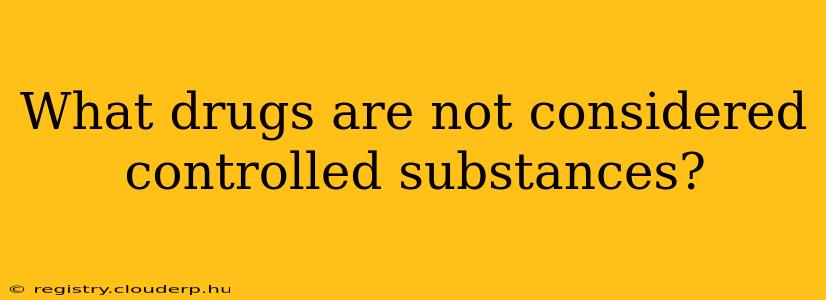Navigating the complex world of pharmaceuticals and their legal classifications can be challenging. Understanding which drugs are not considered controlled substances is crucial for both personal safety and legal compliance. This comprehensive guide will clarify the distinction, explaining what constitutes a controlled substance and highlighting examples of medications that fall outside this regulatory framework.
Many over-the-counter (OTC) and prescription medications are readily available without the legal restrictions placed on controlled substances. The key difference lies in their potential for abuse and dependence. Controlled substances are categorized based on their potential for addiction and their accepted medical use. Drugs that lack this high potential for abuse and have established medical applications are generally not classified as controlled substances.
What is a Controlled Substance?
Before identifying which drugs aren't controlled, understanding what is a controlled substance is essential. In the United States, the Controlled Substances Act (CSA) categorizes drugs into five schedules (I-V) based on their potential for abuse, medical use, and accepted safety under medical supervision. Schedule I drugs have a high potential for abuse and no currently accepted medical use, such as heroin or LSD. Schedule II drugs have a high potential for abuse with a currently accepted medical use, such as morphine or oxycodone. The schedules decrease in potential for abuse as the numbers increase, with Schedule V having the lowest potential.
Drugs that aren't listed in any of these schedules are, by default, not considered controlled substances.
Examples of Non-Controlled Substances:
Many common medications fall outside the realm of controlled substances. These include:
-
Over-the-counter (OTC) pain relievers: Acetaminophen (Tylenol), ibuprofen (Advil, Motrin), and naproxen (Aleve) are readily available and not considered controlled substances due to their low potential for abuse and widespread use under medical guidance.
-
Many prescription medications: While many prescription drugs are controlled substances (opioids, stimulants, etc.), many others are not. Examples include medications for high blood pressure (like lisinopril or metoprolol), cholesterol (like atorvastatin), and many antibiotics. The absence of high abuse potential is the key factor in their non-controlled status.
-
Vitamins and supplements: Generally, vitamins and supplements are not regulated as controlled substances. However, it's crucial to remember that this doesn't mean they are risk-free. Always consult a healthcare professional before starting any new vitamin or supplement regimen.
Commonly Asked Questions:
Are all prescription drugs controlled substances?
No, absolutely not. The vast majority of prescription drugs are not controlled substances. Only those with a high potential for abuse are classified as such.
Can a non-controlled substance be harmful?
Yes, even though a drug is not a controlled substance, it can still have side effects and potential dangers if misused or taken incorrectly. Always follow your doctor's instructions and consult with a healthcare professional about any concerns.
How can I tell if a drug is a controlled substance?
You can consult the official schedules of controlled substances published by your country's drug regulatory agency. In the U.S., the DEA website is a good resource. Alternatively, you can always ask your pharmacist or doctor.
What are the legal implications of possessing a controlled substance without a prescription?
The legal implications of possessing a controlled substance without a prescription vary widely depending on the jurisdiction and the specific drug. Penalties can range from fines to imprisonment. It's crucial to always adhere to local and national laws regarding controlled substances.
Disclaimer: This information is for general knowledge and does not constitute medical or legal advice. Always consult a healthcare professional or legal expert for personalized guidance. This information is current as of October 26, 2023. Laws and regulations regarding controlled substances can change.

